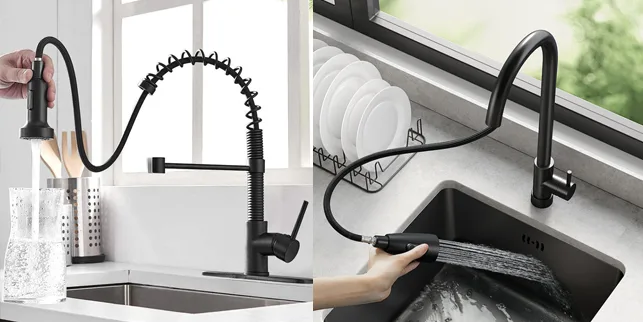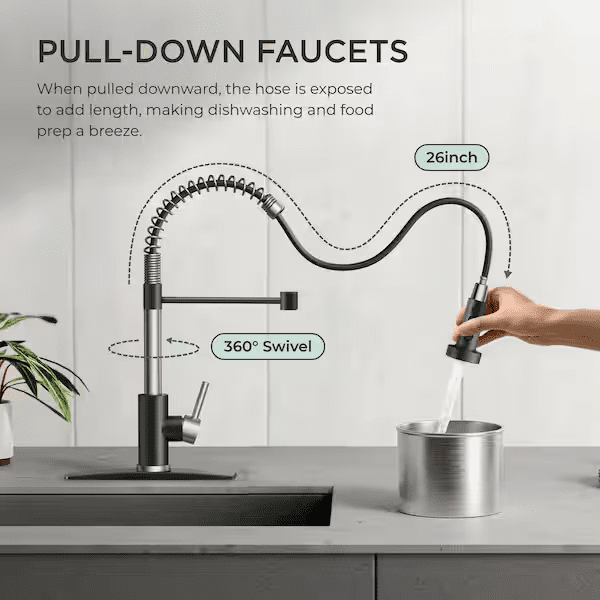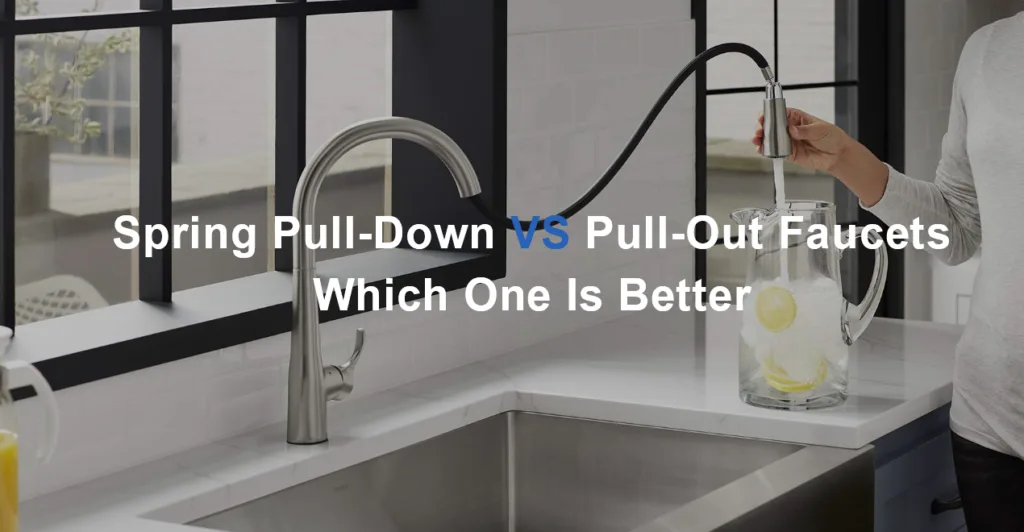Spring Pull-Down VS Pull-Out Faucets: Which Kitchen Faucet is Right for You?
Contemporary kitchens are not about appearances they’re about convenience, flexibility, and smart functionality. One of the more contentious choices you may have when upgrading your kitchen is choosing a spring pull down faucet or a pull out faucet. If your kitchen is undergoing a complete remodel, or you are simply replacing fixtures, knowing the differences between a spring faucet and the alternatives, can assist you in making a practical choice. Both designs are flexible, but differ in their design, functionality, and application.
In this article, our company summarize the pros and cons of spring pull down vs pull out faucets so that you can select the one most appropriate to your lifestyle.
What is a Spring Pull-Down Faucet?
Spring faucets offer a commercial-style appearance thanks to their tall, flexible coil spring neck. Previously, they were only found in restaurant kitchens but today, they have the industrial grade power and reach to come to your home. The spout is flexible and can be moved freely in any direction providing the perfect solution for deep sinks or reaching around for multi-tasking. Spring faucets also provide high arcs with powerful spray modes and performance for the modern home, and provide the user with durability particularly if you cook regularly or have large pots and pans.
Pros:
- The use of high mobility and reach.
- Ideal for deep or double sinks.
- Provides a professional look to the kitchen.
Cons:
- Can be too much for small sinks or small spaces
- Higher water flow may cause splashing.
What is a Pull-Out Faucet?
Unlike a pull-down model, a pull-out faucet has a low arc and is a compact-sized faucet. The spray head pivots straight out, not down. The pull-out is best for tighter kitchen spaces, and provides you decent range without overwhelming the sink area.
Pros:
- Lower spout height, suitable for tight spaces
- Hose pulls out horizontally towards user
- Greater reach when utilising sink corner to corner
- Usually less expensive and easier to care for
Cons:
- More higher than standard designs.
Pull-out faucets are ideal when a user has low overhead in their home, or if they don’t mind their faucet looking subdued and minimalistic, but would like flexibility when using it.
Kitchen Faucet Comparison Table
| Features | Spring Pull-Down Faucet | Pull-Out Faucet |
|---|---|---|
| 1: Hose Reach | Excellent Vertical+Swivel | Good horizontal |
| 2: Best For | Deep sinks, modern designs | Compact kitchens, tight spaces |
| 3: Water Pressure | Strong, spray-focused | Gentle, more controlled |
| 4: Maintenance | Moderate | Easy |
| 5: Installation | Slightly complex | Simple |
| 6: Style | Commercial/Modern | Compact/functional |
Design Aesthetics: Which Looks Better In Your Kitchen?
Spring faucets are ubiquitous in high-end kitchen design. Their industrial, professional look gives a dynamic, contemporary look. They look great with stainless steel sinks and granite countertops.
Pull-out faucets tend to have a more practical, compact styling, and are easily incorporated in both traditional and minimalist kitchens. It is a widely known fact that if you are in limited space – like smaller apartments or classic interiors.
Visual impact vs. space-saving: A spring faucet is an excellent choice if your kitchen has space and you want to be bold. A pull-out faucet is an excellent choice if you like function and neatness in small scale space saving.
Learn More: Touchless Faucets: Are They Worth It?
1: Installation & Compatibility

A spring pull-down faucet typically requires a stronger and steadier base due to its height and weight. Sometimes you might need more height to ensure the faucet fits into a kitchen with low overhanging cabinets. However, most spring faucets provide installation versatility. You can install many spring tap into single or three holes, which creates some corner cases for sink configurations.
In comparison, pull-out faucets tend to be much lighter and smaller, requiring less installation work, especially for DIY-ers. Pull-out faucets usually have a more straightforward installation that will fit the standard sink configuration without the need for more support or pulling and reworking a typical sink base. This simplicity and flexibility often favors homeowners looking for a quicker installation without professional involvement or a toolbox.
2: Water Pressure & Spray Functionality
Spring pull-down faucets generally provide better water pressure and more spray modes, a concentrated jet, wide spray, or a pause option. In connection with urban living and heavy-duty activities such as washing pots, or quickly rinsing down more than one dish, pull-downs are more well-suited for intensive kitchen tasks.
Pull-out faucets still provide flexibility in spray and stream modes but not as forceful. The pull-out faucet is indicated for everyday uses: rinsing fruit or washing off small items but may not be as forceful or the same spray modes for larger utensils where you might be rinsing glasses or dishes.
3: Durability & Material Quality

Both pull down and pull out taps are made from very durable finishes like stainless steel, brushed nickel, and matte black, making them appear like versions of themselves while appearing in different kitchens. Obviously the quality and durability of the taps are not the same because of the unique internal components and finishing materials.
A pull down faucets typical ecosystem is constructed with professional grade components, making it an excellent choice for areas of heavy use. An added bonus is the fact that the taps do not wear out, due to the very strong parts, such springs and valves, the taps are rated to perform excellently on constant use. The pull out faucet mostly is produced in varying quality materials, which relies on if the brand is mid-range or not.
4: Maintenance & Cleaning
Faucet design and build will dictate the total effort it takes to clean and maintain a faucet while keeping it looking its best and functioning correctly. Spring pull-down faucets are one style, with external coils and a complicated assembly of parts to create the desired function so maintenance is a concern. The coils will act like huge catch basins for dirt, grease, and mineral deposits over the entire length of the coil – especially in an area with hard water.
Pull-out faucets generally have a modern design and exposed parts that can make maintenance easy. Modern designs limit accumulation in corners and grit buildup on faucet bodies. No long springs or coils to catch dirt and debris and they often look better as well.
5: Pricing & Value For Money
When it comes to choosing a spring pull-down faucet and pull-out faucet; the distinction is price. The spring pull-down faucet is a much sturdier unit and designed for heavy use. A spring pull down faucet typically ranges from $100 to $400 or even more depending upon the brand, material and finish. A bathtub faucet also includes features for bath use and some high-end models can replace the high-end limit of this price range. These prices tend to be a much bigger price commitment for home -owners seeking a durable, higher-end performing, stylish functional faucet for their kitchen.
In contrast, obviously you will find pull-out faucets priced much more attractively. Entry level pull-out faucets can go as low as a basic model of $50 and even pulling premiums with additional benefits other than just a sprayer pattern or construction in the $100 – 200 range, price pays big dividends in consumer categories of pull-out faucets. This budget friendly factor allows the consumer to be part of experiencing a high quality faucet without major investment and add-value when the faucet successfully exudes a more modern fill function in kitchen areas with a smaller budget.
6: Smart Features & Tech Integration in Modern Kitchen Faucets
In today’s tech-savvy world, modern kitchens can turn to technology to increase convenience, efficiency, and usability. Some spring pull-down faucets are even incorporated with smart features including touchless sensors and voice activation. With an automatic faucet, whether it operates when water is turned on or off automatically or by gesture or voice command, the kitchen experience is more sanitary and tactile because there is no need to touch the faucet itself to activate water flow.
Which Faucet Type Saves More Water?

With the water crisis impacting the world, homeowners are seeking to improve water efficiency in their kitchen without losing performance. In faucet types, both spring pull-down and pull-out faucets can come with the feature of aerators and flow restrictors which work to allow us to have less water while also providing an effective stream by allowing air into the stream of water.
That said, pull-out faucets usually count as more efficient with their smaller spray heads and gentler water flow, therefore, they generally use a little less water than spring pull-downs.
With a smaller spray head, pullout faucets can have streamlined more focused flow, and that little decrease in water means pull outs are perfect for rinsing dishes or filling pots without being wasteful.
Conclusion
Choosing between a spring faucet and pull-down faucet, or pull-out faucet is not an easy simple “best” or “worst” decision – just what is best for your kitchen and everyday life. If you want performance and a professional feel, then the spring faucet will be a good option. If you want sleek design and extra height, the pull-down faucet is your option. If you have a smaller kitchen but need flexibility, the pull-out faucet could be a great option. Regardless of what you choose, paying some attention to quality, space, and function will make sure you purchase a kitchen faucet that will enhance your home.
Most Asked Questions About Spring Pull-Down VS Pull-Out Faucets
Q1: Which Is Better For A Small Kitchen — Spring Or Pull-Out Faucet?
Answer: Pull-out faucets are preferable for smaller kitchens since they take up less physical space and the hose pulls in over a horizontal plane.
Q2: Do Spring Faucets Require More Maintenance?
Answer: Yes, they have more exposed sections and can gather dirt faster, and therefore require cleaning more frequently.
Q3: Are Pull-Down And Pull-Out Faucets Compatible With All Sinks?
Answer: There are standard sinks that most are compatible too, but spring faucets may require deeper or stronger installs.
Q4: Can I Install These Faucets Myself?
Answer: Pull-out faucets are easier to do yourself, whereas spring faucets will likely require a professional.
Q5: Do Either Of These Faucets Reduce Water Usage?
Answer: Yes, it can save water on either type if it has an aerator or flow restrictor.

